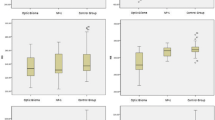Abstract
Purpose
To compare the optical coherence tomography (OCT) findings of neurofibromatosis-1 (NF-1) patients with/without optic pathway glioma (OPG) with those of healthy controls.
Methods
Ten patients with NF-1, 17 patients with NF-1-associated OPGs, and 17 control subjects were included in the study. Retinal nerve fiber layer (RNFL) and macular thickness findings measured with Stratus OCT were compared between the groups.
Results
The average RNFL thickness was significantly lower in the OPG group (76.72 ± 22.16 μm) than in the controls (108.89 ± 9.92 μm) and NF-1 patients without OPGs (111.17 ± 12.13 μm) (p < 0.001). The macular volume was also found to be lower in NF-1 patients with OPG (6.41 ± 0.66 mm3) than in the healthy controls (7.19 ± 0.36 mm3; p = 0.001) and NF-1 patients without OPGs (7.25 ± 0.26 mm3; p = 0.005). Following this analysis the OPG group was further subdivided into two categories: OPG patients with normal visual acuity (VA) and OPG patients with decreased VA. The statistical analysis was repeated for these four subgroups, revealing that while the decrement in the average RNFL thickness was significant for both OPG groups that in the macular volume was only significant for OPG patients with decreased VA.
Conclusion
The results of our study suggest that RNFL thinning can be a helpful marker for the detection of OPGs in NF-1 patients. Larger studies with longitudinal data are required to confirm the role of OCT in the diagnosis and follow-up of these patients.
Similar content being viewed by others
References
Augsburger JJ, Bolling JP. Phakomatoses. In: Yanoff M, Duker JS, editors. Ophthalmology. 2nd ed. St Louis: Mosby; 2004. p. 1097.
Listernick R, Ferner RE, Liu GT, Gutmann DH. Optic pathway gliomas in neurofibromatosis-1: controversies and recommendations. Ann Neurol. 2007;61:189–98.
Listernick R, Charrow J, Greenwald M, Mets M. Natural history of optic pathway tumors in children with neurofibromatosis type 1: a longitudinal study. J Pediatr. 1994;125:63–6.
Kuenzle BC, Weissert M, Roulet E, Bode H, Schefer S, Huisman T, et al. Follow-up of optic pathway gliomas in children with neurofibromatosis type 1. Neuropediatrics. 1994;25:295–300.
Listernick R, Darling C, Greenwald M, Strauss L, Charrow J. Optic pathway tumors in children: the effect of neurofibromatosis type 1 on clinical manifestations and natural history. J Pediatr. 1995;127:718–22.
Balcer LJ, Liu GT, Heller G, Bilaniuk L, Volpe NJ, Galetta SL, et al. Visual loss in children with neurofibromatosis type 1 and optic pathway gliomas: relation to tumor location by magnetic resonance imaging. Am J Ophthalmol. 2001;131:442–5.
Parsa CF, Hoyt CS, Lesser RL, Weinstein JM, Strother CM, Muci-Mendoza R, et al. Spontaneous regression of optic gliomas: thirteen cases documented by serial neuroimaging. Arch Ophthalmol. 2001;119:516–29.
Listernick R, Louis DN, Packer RJ, Gutmann DH. Optic pathway gliomas in children with neurofibromatosis 1: consensus statement from the NF1 optic pathway glioma task force. Ann Neurol. 1997;41:143–9.
Chen J, Lee L. Clinical applications and new developments of optical coherence tomography: an evidence-based review. Clin Exp Optom. 2007;90:317–35.
Sakata LM, Deleon-Ortega J, Sakata V, Girkin CA. Optical coherence tomography of the retina and optic nerve—a review. Clin Exp Ophthalmol. 2009;37:90–9.
Subei AM, Eggenberger ER. Optical coherence tomography: another useful tool in a neuro-ophthalmologist’s armamentarium. Curr Opin Ophthalmol. 2009;20:462–6.
Avery RA, Liu GT, Fisher MJ, Quinn GE, Belasco JB, Phillips PC, et al. Retinal nerve fiber layer thickness in children with optic pathway gliomas. Am J Ophthalmol. 2011;151:542–9.
Chang L, El-Dairi MA, Frempong TA, Burner EL, Bhatti MT, Young TL, et al. Optical coherence tomography in the evaluation of neurofibromatosis type-1 subjects with optic pathway gliomas. J AAPOS. 2010;14:511–7.
Avery RA, Fisher MJ, Liu GT. Optic pathway gliomas. J Neuro-ophthalmol. 2011;31:269–78.
Fisher MJ, Loguidice M, Gutmann DH, Listernick R, Ferner RE, Ullrich NJ, et al. Visual outcomes in children with neurofibromatosis type 1-associated optic pathway glioma following chemotherapy: a multicenter retrospective analysis. Neuro Oncol. 2012;14:790–7.
Ng YT, North KN. Visual-evoked potentials in the assessment of optic gliomas. Pediatr Neurol. 2001;24:44–8.
Wolsey DH, Larson SA, Creel D, Hoffman R. Can screening for optic nerve gliomas in patients with neurofibromatosis type I be performed with visual-evoked potential testing? J AAPOS. 2006;10:307–11.
Liu GT, Malloy P, Needle M, Phillips P. Optic gliomas in neurofibromatosis type 1: role of visual evoked potentials. Pediatr Neurol. 1995;12:89–90.
Danesh-Meyer HV, Carroll SC, Foroozan R, Savino PJ, Fan J, Jiang Y, et al. Relationship between retinal nerve fiber layer and visual field sensitivity as measured by optical coherence tomography in chiasmal compression. Invest Ophthalmol Vis Sci. 2006;47:4827–35.
Danesh-Meyer HV, Papchenko T, Savino PJ, Law A, Evans J, Gamble GD. In vivo retinal nerve fiber layer thickness measured by optical coherence tomography predicts visual recovery after surgery for postchiasmal tumors. Invest Ophthalmol Vis Sci. 2008;49:1879–85.
Fisher JB, Jacobs DA, Markowitz CE, Galetta SL, Volpe NJ, Nano-Schiavi ML, et al. Relation of visual function to retinal nerve fiber layer thickness in multiple sclerosis. Ophthalmology. 2006;113:324–32.
Frohman E, Costello F, Zivadinov R, Stuve O, Conger A, Winslow H, et al. Optical coherence tomography in multiple sclerosis. Lancet Neurol. 2006;5:853–63.
Conflicts of interest
P. Topcu-Yilmaz, None; B. Kasim, None; H. Kiratli, None.
Author information
Authors and Affiliations
Corresponding author
About this article
Cite this article
Topcu-Yilmaz, P., Kasim, B. & Kiratli, H. Investigation of retinal nerve fiber layer thickness in patients with neurofibromatosis-1. Jpn J Ophthalmol 58, 172–176 (2014). https://doi.org/10.1007/s10384-014-0308-6
Received:
Accepted:
Published:
Issue Date:
DOI: https://doi.org/10.1007/s10384-014-0308-6




